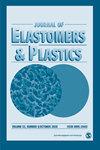脱硫化再生乙烯-丙烯-二烯与低密度聚乙烯三元共聚物混合物的热力学表征
IF 1.6
4区 材料科学
Q4 MATERIALS SCIENCE, MULTIDISCIPLINARY
引用次数: 6
摘要
在这项研究中,得到了低密度聚乙烯(LDPE)和再生弹性体三元共聚物乙丙二烯(EPDM-r)的混合物。EPDM-r是由制造商获得的(硫化),也是在使用微波进行脱硫处理后加入的。用双(α, α-二甲苄基)过氧化物制得混合物。用凝胶含量和扫描电镜对脱硫前后的弹性体残渣进行了表征。所获得的混合物通过热重分析、差示扫描量热法和抗牵引和抗冲击的力学测试进行了表征。残留物分析结果表明,脱硫过程显著降低了弹性体的凝胶含量。所得到的混合物表明,加入硫化EPDM-r降低了结晶焓和熔合焓,同时保持了热塑性塑料的结晶和熔合特性。混合料的变形和牵引强度均有所降低;然而,与纯LDPE相比,掺入改性EPDM-r导致弹性模量值和抗冲击能力显著增加。本文章由计算机程序翻译,如有差异,请以英文原文为准。
Thermal and Mechanical Characterization of a Terpolymer Mixture of Devulcanized Recycled Ethylene-Propylene-Diene and Low-density Polyethylene
In this study, mixtures of low-density polyethylene (LDPE) and the recycled elastomeric terpolymer ethylene-propylene-diene (EPDM-r) were obtained. The EPDM-r was incorporated as obtained by the manufacturer (vulcanized) and also after being submitted to a devulcanization process using microwaves. The mixtures were obtained with the use of bis(α, α-dimethylbenzyl) peroxide. The elastomeric residue was characterized by gel content and scanning electron microscopy, before and after the devulcanization process. The mixtures obtained were characterized by thermogravimetric analysis, differential scanning calorimetry, and mechanical tests for resistance to traction and impact. The results of the analysis of the residues showed that the devulcanization process reduced significantly the gel content of the elastomer. The mixtures obtained demonstrated that the incorporation of vulcanized EPDM-r reduced the crystallization and fusion enthalpies, while conserving the crystallization and fusion characteristics of the thermoplastic. The mixtures showed a reduction in the deformation and traction strength; however, the incorporation of devulcanized EPDM-r led to a significant increase in the elasticity modulus values and the resistance to impact in relation to the pure LDPE.
求助全文
通过发布文献求助,成功后即可免费获取论文全文。
去求助
来源期刊

Journal of Elastomers and Plastics
工程技术-材料科学:综合
CiteScore
3.30
自引率
5.90%
发文量
41
审稿时长
6 months
期刊介绍:
The Journal of Elastomers and Plastics is a high quality peer-reviewed journal which publishes original research on the development and marketing of elastomers and plastics and the area in between where the characteristics of both extremes are apparent. The journal covers: advances in chemistry, processing, properties and applications; new information on thermoplastic elastomers, reinforced elastomers, natural rubbers, blends and alloys, and fillers and additives.
 求助内容:
求助内容: 应助结果提醒方式:
应助结果提醒方式:


